Cochlear Implants: Challenges and Opportunities in Hearing Rehabilitation
A topical collection in Audiology Research (ISSN 2039-4349).
Viewed by 4902Editors
Interests: hearing aids; cochlear implants; hearing loss; tinnitus; vertigo
Special Issues, Collections and Topics in MDPI journals
Topical Collection Information
Dear Colleagues,
Cochlear implants represent nowadays a safe and reliable technique for the successful rehabilitation of profound hearing loss either in newborns with congenital deafness, or in children and adults with progressive hearing loss too severe to be treated with conventional hearing aids. Therefore, children can achieve a normal speech and language development in implantation if performed timely and rehabilitaion is properly designed, allowing them to be integrated in the regular school sistems.
Features of Cochlear Implants are costantly improving. On a side, this is due to Cochlear Implants technological implementaions, such as wireless streaming of phone calls or music directly to the implant, or possible interactions with controlateral hearing aid. On the other side, also indications for implantation are changing, including for example patients with single-sided deafness.
This Topical Collection, we welcome papers focusing on the latest technological developments of Cochlear Implants, on indications (single sided deafness or electroacoustic stimulation), on newly surgical procedures, as well as on all the related aspects related to these devices.
Dr. Andrea Ciorba
Dr. Daniele Borsetto
Collection Editors
Manuscript Submission Information
Manuscripts should be submitted online at www.mdpi.com by registering and logging in to this website. Once you are registered, click here to go to the submission form. Manuscripts can be submitted until the deadline. All submissions that pass pre-check are peer-reviewed. Accepted papers will be published continuously in the journal (as soon as accepted) and will be listed together on the collection website. Research articles, review articles as well as short communications are invited. For planned papers, a title and short abstract (about 100 words) can be sent to the Editorial Office for announcement on this website.
Submitted manuscripts should not have been published previously, nor be under consideration for publication elsewhere (except conference proceedings papers). All manuscripts are thoroughly refereed through a single-blind peer-review process. A guide for authors and other relevant information for submission of manuscripts is available on the Instructions for Authors page. Audiology Research is an international peer-reviewed open access semimonthly journal published by MDPI.
Please visit the Instructions for Authors page before submitting a manuscript. The Article Processing Charge (APC) for publication in this open access journal is 1400 CHF (Swiss Francs). Submitted papers should be well formatted and use good English. Authors may use MDPI's English editing service prior to publication or during author revisions.
Keywords
- audiology
- cochlear implants
- hearing loss
- tinnitus
- rehabilitation
- ear surgery











